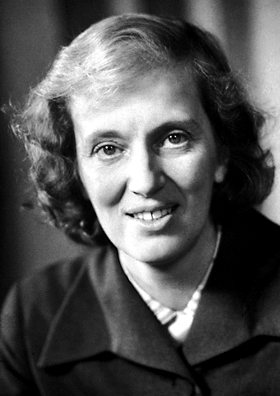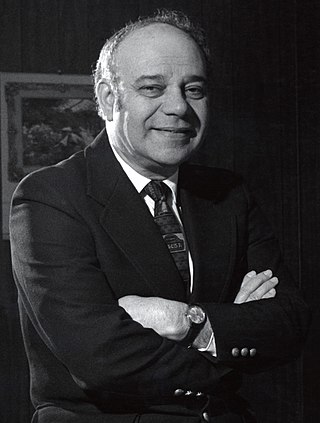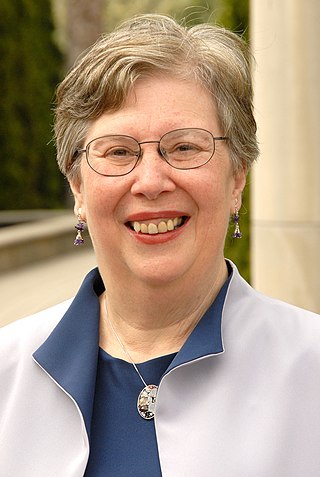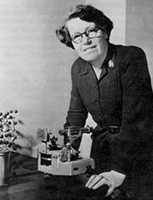
Crystallography is the experimental science of determining the arrangement of atoms in crystalline solids. Crystallography is a fundamental subject in the fields of materials science and solid-state physics. The word crystallography is derived from the Ancient Greek word κρύσταλλος, with its meaning extending to all solids with some degree of transparency, and γράφειν. In July 2012, the United Nations recognised the importance of the science of crystallography by proclaiming that 2014 would be the International Year of Crystallography.

Dorothy Mary Crowfoot Hodgkin was a Nobel Prize-winning British chemist who advanced the technique of X-ray crystallography to determine the structure of biomolecules, which became essential for structural biology.

A chemical structure of a molecule is a spatial arrangement of its atoms and their chemical bonds. Its determination includes a chemist's specifying the molecular geometry and, when feasible and necessary, the electronic structure of the target molecule or other solid. Molecular geometry refers to the spatial arrangement of atoms in a molecule and the chemical bonds that hold the atoms together and can be represented using structural formulae and by molecular models; complete electronic structure descriptions include specifying the occupation of a molecule's molecular orbitals. Structure determination can be applied to a range of targets from very simple molecules to very complex ones.

Jerome Karle was an American physical chemist. Jointly with Herbert A. Hauptman, he was awarded the Nobel Prize in Chemistry in 1985, for the direct analysis of crystal structures using X-ray scattering techniques.
Fox Chase Cancer Center is a National Cancer Institute-designated Comprehensive Cancer Center research facility and hospital located in the Fox Chase section of Philadelphia, Pennsylvania, United States. The main facilities of the center are located on property adjoining Burholme Park. The center is part of the Temple University Health System (TUHS) and specializes in the treatment and prevention of cancer.

Helen Miriam Berman is a Board of Governors Professor of Chemistry and Chemical Biology at Rutgers University and a former director of the RCSB Protein Data Bank. A structural biologist, her work includes structural analysis of protein-nucleic acid complexes, and the role of water in molecular interactions. She is also the founder and director of the Nucleic Acid Database, and led the Protein Structure Initiative Structural Genomics Knowledgebase.
Judith Ann Kathleen Howard is a British chemist, crystallographer and Professor of Chemistry at Durham University.

Isabella Karle was an American chemist who was instrumental in developing techniques to extract plutonium chloride from a mixture containing plutonium oxide. For her scientific work, Karle received the Garvan–Olin Medal, Gregori Aminoff Prize, Bower Award, National Medal of Science, and the Navy Distinguished Civilian Service Award.

Helen Dick Megaw was an Irish crystallographer who was a pioneer in X-ray crystallography. She made measurements of the cell dimensions of ice and established the Perovskite crystal structure.
The American Crystallographic Association, Inc. (ACA) is a non-profit, scientific organization for scientists who study the structure of matter via crystallographic methodologies. Since its founding in 1949 it has amassed over 2000 members worldwide.

Elspeth Frances Garman is professor of molecular biophysics at the University of Oxford and a former President of the British Crystallographic Association. She was also Senior Kurti Research Fellow at Brasenose College, Oxford, retiring in 2021. The "Garman limit", which is the radiation dose limit of a cryocooled protein crystal, is named after her.
Elizabeth Armstrong Wood (1912–2006) was an American crystallographer and geologist who ran a research program at Bell Telephone Laboratories that led to the development of new superconductors and lasers. She was known for the clarity of her writing and her efforts to educate the general public about scientific subjects.

Margaret Cairns Etter, known informally as Peggy Etter, was an American chemist who contributed to the development of solid state chemistry for crystalline organic compounds. She is known for her work characterizing and classifying contacts by hydrogen bonds in organic compounds. Her "enlightened imagination, innovative creativity, and unfailing enthusiasm" is recognised as having a "transformative effect" in many areas of organic chemistry.
Ulrich Müller is a German chemist that is known for his works on solid-state chemistry and the application of crystallographic group theory to crystal chemistry. He is the author of several textbooks on chemistry, solid-state chemistry, and crystallography.
Miriam Rossi is an Italian-American chemist and the Mary Landon Sague Chair at Vassar College. She works on x-ray crystallography and chemistry education.

Barbara Wharton Low was a biochemist, biophysicist, and a researcher involved in discovering the structure of penicillin and the characteristics of other antibiotics. Her early work at Oxford University with Dorothy Hodgkin used X-ray crystallography to confirm the molecular structure of penicillin, which at the time was the largest molecule whose structure has been determined using that method. Later graduate work saw her study with Linus Pauling and Edwin Cohn before becoming a professor in her own right. Low's laboratory would accomplish the discovery of the pi helix, investigate the structure of insulin, and conduct research into neurotoxins.
Clara Brink Shoemaker was a Dutch-born American crystallographer and a senior research professor at Oregon State University. As a postdoctoral researcher, she worked on the structure determination of vitamin B12 in the group of Dorothy Hodgkin. Together with her husband, David Shoemaker, she contributed to the research on transition metal phases and intermetallic compounds. They were the first to recognize that interstices in tetrahedrally close-packed metal crystals are exclusively tetrahedral and only have four types of coordination polyhedra.
June Monica Lindsey was a British-Canadian physical chemist. Whilst working on X-ray crystallography at the University of Cambridge, Lindsey was influential in the elucidation of the structure of DNA. She solved the structures of the purines, adenine and guanine. Her depiction of intramolecular hydrogen bonds in adenine crystals was central to Watson and Crick's elucidation of the double helical structure of DNA.

Winnie Kwai-Wah Wong-Ng is a Chinese-American physical chemist. She is a research chemist at the ceramics division at the National Institute of Standards and Technology. Her research includes energy applications, crystallography, thermoelectric standards, metrology, and data, sorbent materials for sustainability, and high throughput combinatorial approach for novel materials discovery and property optimization for energy conversion applications. She is a fellow of the International Centre for Diffraction Data, American Ceramic Society, American Crystallographic Association, and the American Association for the Advancement of Science. Wong-Ng was twice awarded the Department of Commerce Bronze Medal.
John R. Helliwell is a British crystallographer known for his pioneering work in the use of synchrotron radiation in macromolecular crystallography.











